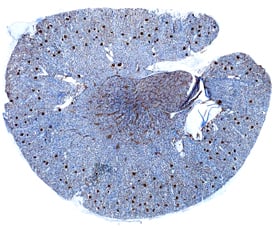Rat LYVE-1 Antibody
R&D Systems, part of Bio-Techne | Catalog # AF7939

Key Product Details
Species Reactivity
Rat
Applications
Immunohistochemistry, Western Blot
Label
Unconjugated
Antibody Source
Polyclonal Sheep IgG
Product Specifications
Immunogen
Mouse myeloma cell line NS0-derived recombinant rat LYVE-1
Thr53-Thr259
Accession # NP_001099756
Thr53-Thr259
Accession # NP_001099756
Specificity
Detects rat LYVE-1 in direct ELISA and Western blots. In direct ELISAs, approximately 50% cross-reactivity with recombinant mouse LYVE-1 is observed, and approximately 10% cross-reactivity with recombinant human LYVE-1 is observed.
Clonality
Polyclonal
Host
Sheep
Isotype
IgG
Scientific Data Images for Rat LYVE-1 Antibody
Detection of Rat LYVE‑1 by Western Blot.
Western blot shows lysates of rat lymph node tissue. PVDF membrane was probed with 1 µg/mL of Sheep Anti-Rat LYVE-1 Antigen Affinity-purified Polyclonal Antibody (Catalog # AF7939) followed by HRP-conjugated Anti-Sheep IgG Secondary Antibody (Catalog # HAF016). A specific band was detected for LYVE-1 at approximately 60 kDa (as indicated). This experiment was conducted under reducing conditions and using Immunoblot Buffer Group 1.LYVE‑1 in Rat Kidney.
LYVE-1 was detected in perfusion fixed frozen sections of rat kidney using Sheep Anti-Rat LYVE-1 Antigen Affinity-purified Polyclonal Antibody (Catalog # AF7939) at 1.7 µg/mL overnight at 4 °C. Tissue was stained using the Anti-Sheep HRP-DAB Cell & Tissue Staining Kit (brown; Catalog # CTS019) and counterstained with hematoxylin (blue). Specific staining was localized to glomeruli. View our protocol for Chromogenic IHC Staining of Frozen Tissue Sections.Applications for Rat LYVE-1 Antibody
Application
Recommended Usage
Immunohistochemistry
5-15 µg/mL
Sample: Perfusion fixed frozen sections of rat kidney
Sample: Perfusion fixed frozen sections of rat kidney
Western Blot
1 µg/mL
Sample: Rat lymph node tissue
Sample: Rat lymph node tissue
Formulation, Preparation, and Storage
Purification
Antigen Affinity-purified
Reconstitution
Sterile PBS to a final concentration of 0.2 mg/mL. For liquid material, refer to CoA for concentration.
Formulation
Lyophilized from a 0.2 μm filtered solution in PBS with Trehalose. *Small pack size (SP) is supplied either lyophilized or as a 0.2 µm filtered solution in PBS.
Shipping
Lyophilized product is shipped at ambient temperature. Liquid small pack size (-SP) is shipped with polar packs. Upon receipt, store immediately at the temperature recommended below.
Stability & Storage
Use a manual defrost freezer and avoid repeated freeze-thaw cycles.
- 12 months from date of receipt, -20 to -70 °C as supplied.
- 1 month, 2 to 8 °C under sterile conditions after reconstitution.
- 6 months, -20 to -70 °C under sterile conditions after reconstitution.
Background: LYVE-1
Long Name
Lymphatic Vessel Endothelial Hyaluronan Receptor 1
Alternate Names
LYVE1, XLKD1
Gene Symbol
LYVE1
UniProt
Additional LYVE-1 Products
Product Documents for Rat LYVE-1 Antibody
Product Specific Notices for Rat LYVE-1 Antibody
For research use only
